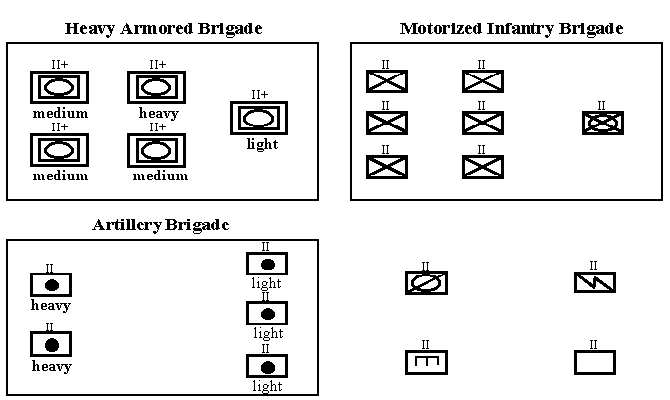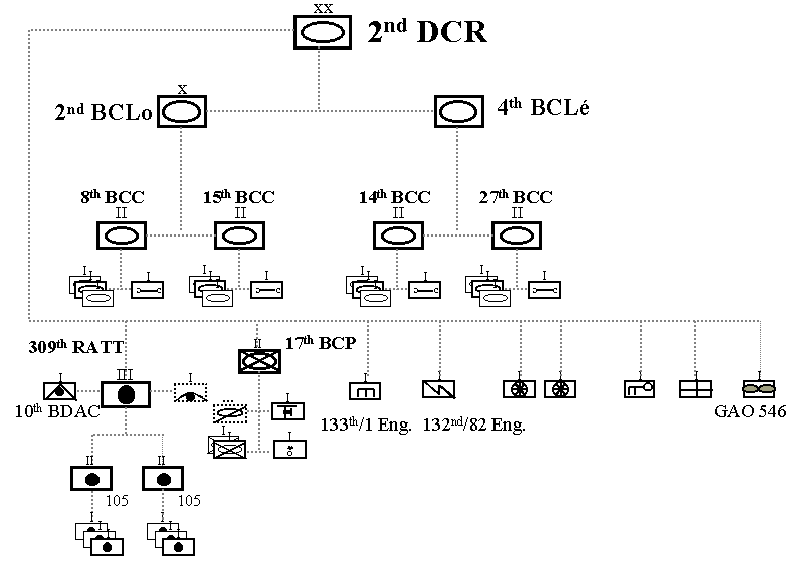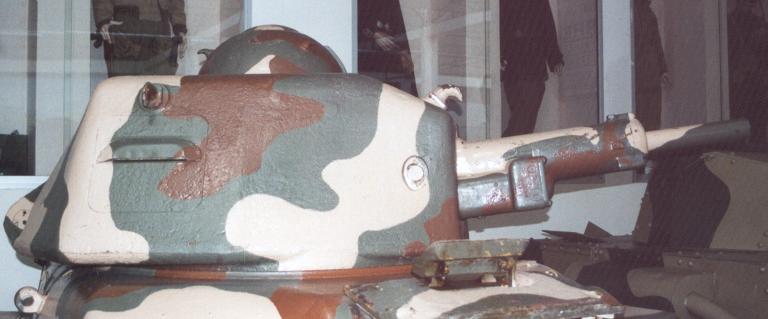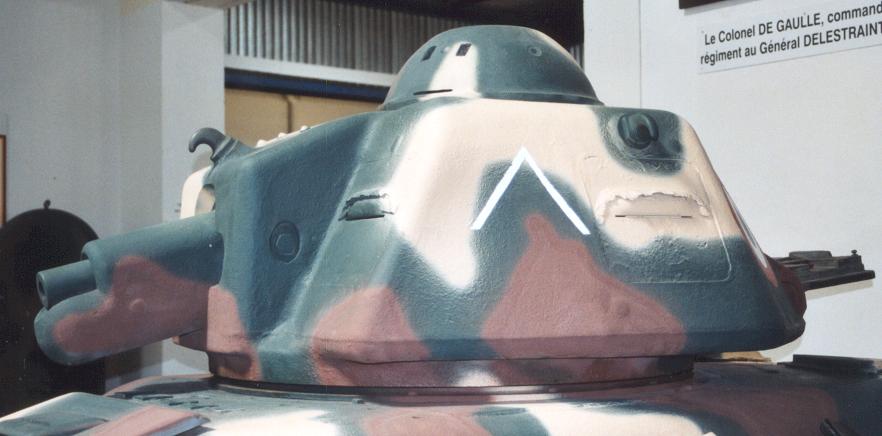De Gaulle's Line division

In 1934, Colonel De Gaulle published his famous book Vers l'Armée de métier (towards a professional Army). In this book, colonel De Gaulle suggested the creation of an army of maneuver and mechanized shock, armored, constituted with elite personnel. This elite army would consist of a light division and 6 line divisions. The personnel would be 100 000 professional soldiers with 6-years contract. The parallel with General Estienne's Brussels conference of 1920 is stricking. Even more stricking is the composition of PanzerGroup Kleist in 1940: 5 Panzer Divisions and 3 Motorized Divisions (approximatly 100 000 men).
De Gaulle's Line division

De Gaulle's line division was to consist of:
- an heavy armored brigade
with a heavy tank regiment, a medium tank regiment and a light tank battalion
for recon
- an infantry brigade with
two infantry regiments and a Chasseurs battalion
- an artillery brigade with
an heavy howitzer regiment and a light gun regiment, together with an AA
battalion
In addition to these 3 brigades, the division had a recon battalion,
a signal battalion, an engineer battalion, a camouflage battalion and an
aircraft group
At that time, french defensive strategy could hardly justify such an offensive army ! Colonel De Gaulle would then look for politicians support. In March 1935, Paul Reynaud would present before the Parlament De Gaulle's project at a time when the principal subject was: How to cope with french declining natality ? a longer military service or a professional army ?
The creation of Panzer Divisions in Germany would finally overcome all resistance against armored divisions. Generals like Héring and Billotte would give their support to the creation of french armored divisions. General Héring would warn everyone against the creation of two different types of armored formations (infantry DCR and cavalry DLM). In 1938, a long time supporter of interarms cooperation, General Héring suggested that the armored division be organized in armored combat groups but he could not convince General Gamelin (the american armored division would use such an organization with their Combat Command). General Billotte would first support the decision to create two armored divisions in december 1938, and then to create a third one in december 1939.
During 1936, the French Army studied what would become the organisation of its armored divisions. On may, 1st, 1937, a complete Panzer Division paraded in Berlin under hundred of planes. During the summer 1937, a secret exercise took place in the Sissonne camp to determine the thrue power of a B1 tank attack. Impressed by the exercise, the army decided to order more battle tanks and to take the first step towards armored divisions. The armored division was to consist of two mixed brigades (each with 3 battle tank battalions and two infantry battalions), an artillery regiment (36 guns+ an AT battery + an AA battery), a recon battalion, a signal battalion and an engineer battalion. A study group of tanks was organized in Nancy in february 1938 to study the tactical use of the armored divisions with 3 B1/B1bis battalions, one D2 battalion, two mechanized Chasseurs battalions and one artillery group. The slow production of battle tanks required to reduce the number of tank battalions to four. The 1938 armored division was to consist of two mixed half-brigades (each with two battle tank battalions and one infantry battalion) with the same support units. It was at that time that General Héring suggested that the armored division be organized in two armored combat groups: each with two battle tank battalions, one infantry battalion, a recon company, an engineer company, a signal company, an AT battery and an AA battery. The artillery regiment with its 36 guns was the only element not dispatched between the two armored combat groups. In december 1938, General Billotte supported the decision to create two armored divisions. But General Colson warned that they would not be ready before 1941. They were to be called Division Cuirassée de Réserve (Reserve Armored Division) to avoid confusion with De Gaulle's professional division. The first armored brigade was created on september 2nd, 1939, one day before France declared war !
On september, 11th, 1939, colonel De Gaulle sent
a letter to the French High Command about his combat experience with the
24th BCC. Again, he required the organisation of armored divisions with
at least 4 tank battalions. He also suggested to regroup the various light
tank battlions into autonomopus brigades under the direct command of an
Army General to avoid tank scattering. But he did not receive approbation
by the French High Command. On december, 17th, 1939, General Billotte requested
that three armored divisions be organized before spring 1940. However,
this would lead to a further weakening of the armored division: two battle
tank battalions were to be replaced by light tank battalions. The DCR was
about to consist of:
- one heavy tank half-brigade
with two battle tank battalions
- one light tank half-brigade
with two light tank battalions
- one mechanized Chasseurs
battalions
- one artillery regiment
- one engineer company,
one signal company and an aircraft group
In a last attempt, colonel De Gaulle sent a Memorandum
to 80 key figures on January, 26th, 1940, called " The Accession of Mechanized
Forces". But apart from General Billotte 's support, no one was convinced
by De Gaulle's ideas.
The first two DCRs had already been created on January, 16th, 1940.
The third DCR would be created on March, 20th, 1940.
| 1st DCR | 2nd DCR | 3rd DCR | 4th DCR (in formation)1 | |
| 1 Heavy tank half-brigade:
- 34 heavy tanks - 34 heavy tanks |
28th BCC (B1bis) 37th BCC (B1bis) |
8th BCC (B1bis) 15th BCC (B1bis) |
41st BCC (B1bis) 49th BCC (B1bis) |
46th BCC (B1bis) 19th BCC + 345th CACC(D2) |
| 1 Light tank half-brigade:
- 45 light tanks - 45 light tanks |
25th BCC (H-39) 26th BCC (H-39) |
14th BCC (H-39) 27th BCC (H-39) |
42th BCC (H-39) 45th BCC (H-39) |
2nd BCC (R-35) 24th BCC (R-35) |
| Mechanized Chasseurs Batt. | 5th BCP | 17th BCP | 16th BCP | 4th BCP (no APCs) |
| Artillery Regiment:
- 24 105mm howitzers - BDAC (8 47mm AT guns) - AA Bie (6 25mm AA guns) |
305th RATT (with 36 How) 10th BDAC |
309th RATT 10th BDAC |
319th RATT |
322nd RATT (24 75mm) |
1. 4th DCR was to be
created on the 1st July 1940. Since May 11th, the 4th DCR was to be commanded
by colonel De Gaulle. On May 15th, the 4th DCR was created on the spot
with what was available. As soon as the various elements arrived, colonel
De Gaulle sent them right away into the battle. The above Oob refers to
what would be available in the Laon area for the Montcornet and Crécy-sur-Serre
battles. These elements arrived between May, 16th to 18th. The 4th DCR
would also received elements that were supposed to be integrated into the
4th DLM: the 10th Cuirassiers (armored recon) with AMDs P-178 that could
not fire their 25mm AT guns and the 3rd Cuirassiers (armor) with only one
S-35 squadron.

The Armored Division was built around 2 armored brigades:
- a heavy armored half-brigade
with 2 heavy tank battalions
- a light armored half-brigade
with 2 light tank battalions
To follow the tank battalions in their attack, the DCR had a Mechanized
Chasseurs Battalion which was the only infantry unit of the division. For
recon and security, the DCR had a motocyclists company and an AMR platoon
which never existed.
In addition to these Armored Half-Brigades, the DCR possessed an Artillery
Regiment with two groups of 12 105mm howitzers. To this Artillery Regiment
were attached an AT battery of 8 47mm AT guns and an AA battery of 6 AA
25mm guns to provide defence against planes and tanks to the Artillery
Groups.
The Bataillon de Chars de Combat (BCC) equipped with B1bis battle tanks consisted of:
- 1 command B1bis tank and 3 B1bis reserve tanks
- 3 company with each 1 command B1bis tank and 3
platoons of 3 B1bis tanks each
The Bataillon de Chars de Combat (BCC) equipped with Light Hotchkiss tanks consisted of:
- 1 command H-39 tank
- 1 compagnie d'échelon (reserve cie) with 6 H-39 tanks
- 3 company with each 1 command H-39 tank and 4 platoons
of 3 H-39 tanks each1
Therefore, a BCC had either 34 B1bis tanks or 45 H-39 tanks
1In each Hotchkiss platoon, the platoon leader received a tank with the new APX-R1 turret armed with the 37mm SA38 (a 37mm gun of 34 calibres) instead of the APX-R turret armed with the 37mm SA18 gun (a 37mm gun of 20 calibres)

APX-R1 turret with 37mm SA38 gun (Saumur
Tank Museum)

APX-R turret with 37mm SA18 gun (Saumur
Tank Museum)
The Battalion de Chasseurs Portés (BCP) had:
- 1 platoon of AutoMitrailleuse de Reconnaissance (AMR) with 5 AMR. (Never realised)
- 1 company of motocyclists with 4 platoons. Each platoon had a command squad of 6 men and two combat squads of 10 men with 2 LMGs each, transported by 13 side-cars (one for two men). In addition to the 4 platoons, the squadron had 1 60mm mortar (4-men crew on 2 side-cars) and a command platoon of 30 to 40 men with a few vehicules (2 trucks, 4 pick-up and 2 cars).
- 2 companies of riflemen with 4 combat platoons. The combat platoon had 4 APCs with one command squad of 7 men and 3 combat squads of 12 men with 2 LMGs each. In addition to these platoons, the riflemen company had 1 60-mm mortar (7-men crew in one APC) and a command platoon of 30 to 40 men with 3 trucks. Therefore, each riflemen squadron had about 200 men with 20 armored personnal carriers, 24 LMGs and 1 60mm mortar.
- 1 company of Mitrailleuses et Engins (support company) with 2 MG platoons, one mortar platoon and three anti-tank platoons. The MG platoon had 3 APCs with 4 MMGs (5-men crew). The mortar platoon had 3 APCs with one command squad and 2 81mm mortars with 7-men crews each. The antitank platoon had 3 trucks with one 25mm AT gun (8-men crew). In addition to these platoons, the support squadron should have a command platoon with 4 more trucks. Therefore, the support squadron had 9 APCs and a dozen of trucks with 8 MMGs, 2 81-mm mortars and 9 25mm AT guns
Therefore, a mechanized Chasseurs battalion had 5 AMRs, 64 LMGs,
44 VB rifle grenade launchers, 8 MMGs, 3 60mm mortars, 2 81mm mortars and
9 25mm AT guns
(by comparison, a regular infantry battalion had 36 LMGs, 48 VB
rifle grenade launchers, 16 MMGs, 3 60mm mortars, 2 81mm mortars and 2
25mm AT guns)
The Mechanized Chasseurs Battalion (type DCR) was a powerful unit designed
to follow a heavy B1bis tank attack together with the light tanks to conquer
the ground gained by the heavy tanks.
| 1st DCR | 2nd DCR | 3rd DCR | 4th DCR (in formation)1 | |
| 1 armored half-brigade: |
new 28th BCC (B1bis) 34th BCC (R-35) |
remmants 8th/15th BCC (B1bis) + 347th, 348th and 349th CACC (B1bis) remmants 14th/27th BCC (H-39) + 351st CACC (H-39) |
remmants 41st/49th BCC (B1bis) 10th BCC (R-35) |
46th BCC (B1bis) 47th BCC (B1bis) |
| 1 armored half-brigade: |
1st BCC (R-35) new 25th BCC (H-39) |
40th BCC (R-35) 48th BCC (R-40) |
remmants 42th BCC (H-39) remmants 45th BCC (H-39) |
2nd/24th BCC (R-35) 44th BCC (R-35) |
| Mechanized Chasseurs Batt. | 5th BCP (probably in trucks) | remmants 17th BCP | remmants 16th BCP | 4th BCP (no APCs)
7th RDP (two battalions) |
| Artillery Regiment:
- 24 105mm howitzers - BDAC (8 47mm AT guns) - AA Bie (6 25mm AA guns) |
305th RATT (12 105mm)
sent to 2nd DCR |
309th RATT 10th BDAC |
319th RATT |
322nd RATT (24 105mm) 10th and 11th BDAC 1020/404 Bie |
After its disastrous confrontation with General Hoth's Panzer Korps, the 1st DCR was rebuilt under the command of General Welvert with one new B1bis battalion, one new H-39 battalion and two R35 battalions taken from 5th Army. The 5th BCP was reconstituted and the 305th RATT had only 12 105mm howitzers. This division would be engaged together with the 4th DLM, trying to delay the General Hoepner's Panzer Korps after the Oise crossing.
The defense of the Oise bridges in small groups of tanks would be fatal to the 2nd DCR which was nearly completely destroyed by PanzerGroup Kleist between May, 17th to 19th. On May, 20th, the 2nd DCR had only 10 B1bis and 12 H-39 left. From May, 20th to 26th, the 2nd DCR was rebuilt in the Noyon area with 40th BCC (R-35) and 48th BCC (R-40), 347th CACC (B1bis), 348th CACC (B1bis), 349th CACC (B1bis) and 351st CACC (H-39). From May, 26th to 31st, the 2nd DCR changed positions 5 times to the south of Amiens at GQG request until it was finally decided to engage the DCR against the Abbeville bridgehead. For its attack on June, 4th, the 2nd DCR had 21 B1bis, 35 H-39, 45 R-35 and 37 R-40. At the end of the day, the 2nd DCR was left with 6 B1bis, 12 H-39, 20 R-35 and 35 R-40.
After the heavy fighting in the Stonne area, the 3rd DCR would be held in reserve to the south of Rethel on the Aisne Front. The 3rd DCR was left with 30 B1bis and 50 H-39. From June, 7th, it received the 10th BCC (R-35) from the 4th Army. As part of Armored Group Buisson (together with 7th DLM), the 3rd DCR counterattacked PanzerGroup Guderian on June, 10th after the successfull German crossing of the Aisne. Although the German had a hard time in Juniville and Perthes, the counterattack did not succeed in throwing back the Germans.
After its counterattacks in Montcornet and Crécy-sur-Serre, the 4th DCR was transferred to the Somme front to reduce the Abbeville bridgehead. The 19th BCC with 345th CACC (D2 tanks) were detached from the 4th DCR to counterattack the Amiens bridgehead. Before its attack, on May 28th, the 4th DCR had 46th BCC (13 B1bis), 47th BCC (19 B1bis), 2th/24th BCC (20 R-35), 44th BCC (45 R-35), 10th Cuirassiers (14 AMD P-178) and 3rd Cuirassiers (20 S-35 and 40 H-39). In addition to the 322nd RATT, the 4th DCR received the 305th RATT with 12 105mm howitzers, 661st and 665th BDAC (47mm AT guns) and the 51st self-propelled 47mm AT battery (two platoons of each 5 Laffly W15 TCC 47mm tank destroyers).
Back to Homepage